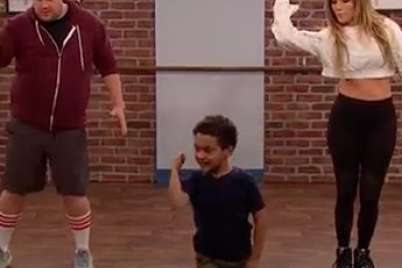
Six secrets to raising confident and active girls
I wasn’t an athletic child. Growing up in the 1980s, a time when “you throw like a girl” was still an insult, I seldom made my elementary school’s sports teams (and if I did, rarely made it off the bench).
It wasn’t that I was inactive — I rode my bike, played skipping rope games, and took swimming lessons — but I had difficulty grasping many of the basic physical literacy skills needed to excel in organized sports.
Even though my childhood is 30 years behind me, the stereotype of young girls in sport — and the challenge of getting them active — persists today.
“These are the ideologies and characteristics that are being associated with being female and that often lead to female youth lacking physical literacy skills because of the fear of being deemed not feminine,” says Gabriela Estrada, the tour de force behind Motivate Canada’s Female Physical Literacy Project.
An avid athlete herself, Estrada’s work with Motivate Canada has resulted in young girls developing the physical literacy skills and confidence to take up new sports, compete on teams, and inspire their peers to do the same.
In a busy, technology-reliant world where media often sends mixed messages about body image and fitness, encouraging young girls to be active can be challenging for some parents. Here are some tips from Estrada to help you raise confident and active girls.
1. Understand physical literacy fundamentals
Physical literacy starts with movement skills that all children need, such as running, hopping, throwing, catching, and jumping. It’s the development of the whole child, not just judging how fast they run or how well they perform on a sports field. These fundamental movement skills in turn give kids the confidence to participate in different physical activities, sports, and games.
Estrada suggests that parents first look at resources that can help them gauge their daughter’s physical literacy. Canadian Sport for Life’s physical testing tool PlayFUN helps parents assess what level their child is at.
Active for Life’s website also has free resources, including games and tips, to help your daughter develop her physical literacy. Estrada points out that the focus should always be on the fun, suggesting parents make a game out of drills and activities.
2. Provide young girls with realistic role models
Estrada says that as inspiring as elite athletes can be, some of the best role models for young girls are other women who are passionate about physical literacy and keeping people active, such as parents and teachers.
“Show them that not all female athletes look like the girls on magazine covers and social media, and not all have six-packs [abdominal muscles] or train for three hours a day,” she explained. “Show them the role models they know, or the ones they have in their lives.”
Estrada points to Shauna Harrison, a multisport athlete with her Ph.D in public health, and Christine Sinclair, the captain of Canada’s national soccer team, as two of her role models.
3. Use free play as an opportunity to have girls move their bodies in different ways
Could our increased reliance on technology be to blame for the decline of free play and physical literacy? Estrada believes the two are linked.
“In today’s society, there’s a large focus on technology and not enough on the world of free play, so I think really encouraging female youth to get out and play and to have fun is important,” she said.
Fitting in fitness and free play doesn’t have to be complicated or expensive, so don’t stress out about signing your daughter up for a full slate of extracurricular sports. Activities like walking the dog, or playing soccer or frisbee at recess, are ways to sneak in free play.
4. Find a safe and girl-friendly place for her to exercise
“There are so many instances where females don’t have a safe space where they feel comfortable being physically active, or feel as if they don’t belong because they don’t look a certain way or do a certain action,” says Estrada.
She notes that even with positive body image campaigns from marketers, there still is a huge lack of encouragement from society to get girls to be physical active and literate and be comfortable in their bodies.
“There still is a much larger focus on girls looking good, being pretty, dressing pretty, smelling pretty … rather than being hard working, sweaty, or dirty. The focus is much too great on the aesthetics of the body, the weight on the scale, and not what the body can do when fuelled properly and when given the opportunity.”
While a structured gym class might seem like the right place to start your daughter’s physical literacy journey, Estrada points out that sometimes those settings can be stressful. Small female-only sports groups or classes — where girls and their female relatives or caregivers can even participate alongside them — is an ideal way to boost a girl’s confidence.
“Give them the opportunity to properly learn more about what their body can do within physical literacy and how to do it, without giving them that feeling of having to pass or being scared to fail,” Estrada advises.
5. Get girls running
“I think the biggest challenge and skill set in physical literacy that female youth believe they can’t do or won’t do is running,” says Estrada, who adds that even members of her soccer team balk at running drills.
“Running is something any female can do as an able-bodied individual, but many choose not to do because they don’t think they are meant to or that their body is built to, or don’t want to sweat or work that hard.”
To make running fun, Estrada helped train a group of MCFLP athletes to complete a mud and obstacle run. Rather than telling your daughter to go out and run laps, register for a goal race together to keep her motivated and get her excited about running.
6. Model healthy behaviors and attitudes for your daughter
“Mothers are the most influential women in their daughters’ lives and are often their number one role models. It is of utmost importance for mothers to portray and exhibit the characteristics and habits, as well as morals and values, that they hope to instill in their daughters,” stresses Estrada.
Healthy eating and sleeping habits and making time in your day to be physically active are ways for moms to encourage their daughters to be active for life.
“Mothers can also show and be roles models as to how one is never too ‘old’ to start a sport or just to play one,” she adds. “Show your daughter that you don’t just stop once you’ve reached a certain age or point in your life, but that athleticism can continue.”
This spring, my daughter asked me to take the training wheels off her bike, and each evening she is out on our driveway, wobbling and falling, but doggedly determined to master this skill. As I watch her struggle, I realize it’s not “just” riding a bicycle, it’s something bigger.
Estrada says it best: “Break down barriers, break down stereotypes. Just focus on movement and physical literacy, provide them with opportunities, and create healthier female youth both physically and mentally.”






Great article. I am an endurance runner (ran a marathon last year) and am trying to encourage my 11 year old daughter to run with me. She is overweight and refuses to try. Any advice? I am aware of not pushing to hard and having it back fire. Thanks!
Hi Tara,
Speaking as a coach, teacher, and father of two daughters, absolutely don’t push your daughter to run with you. Two things are most important: fun and “safety” (see point number 4 in the article above). If your goal is to have an active daughter, I will argue that running is the least fun activity available for most people. And I speak as an avid runner who specialized in middle distance through high school and longer distances as an adult recreational runner. One of my daughters found fun in basketball around age 8, and she just finished playing at the high school senior provincial finals, now in grade 12. She loves basketball because it is fun for her. My other daughter discovered badminton around age 11 and became a high-performance competitive player throughout high school. Because it was fun for her. But she hates running with a passion. My best advice to you: Ask your daughter what sports or activities she would like to try, and then find a way to make it happen. Try as many things as necessary until she finds what she loves. I feel pretty confident saying that she will find something. Just be sure to think outside the box of traditional sports — consider things such as dance, martial arts, rock climbing, etc. in addition to things such as soccer, basketball, tennis, etc. Best of luck!
Maybe rephrase this? She isn’t ‘refusing’, just that running isn’t her thing, and to be fair, endurance running isn’t most people’s thing. There are so many ways to do other fun things together that sneak in a bit of movement. E.g. watch some music videos together and try out the dance moves